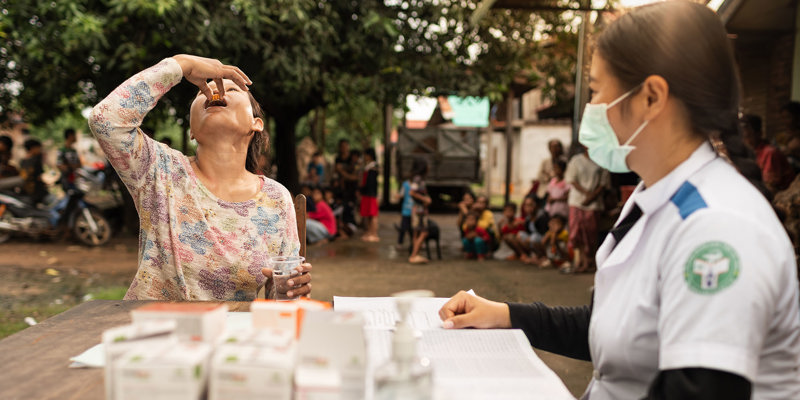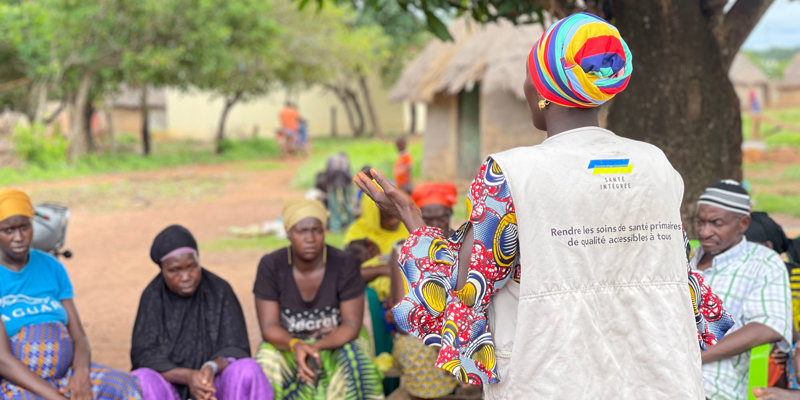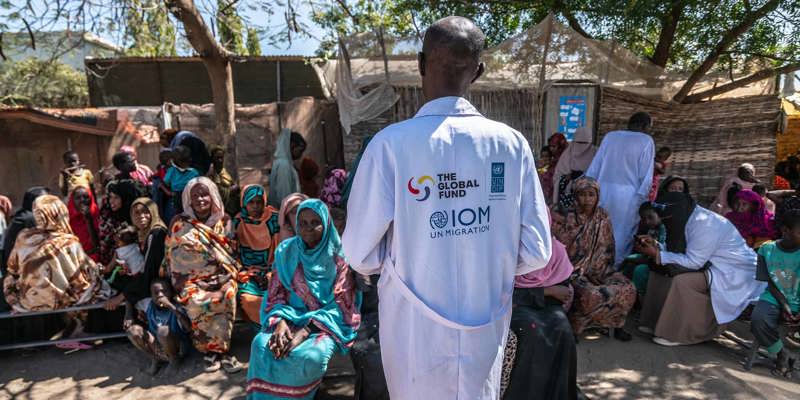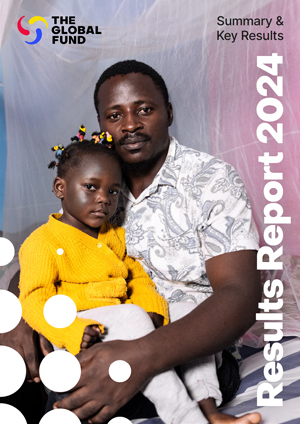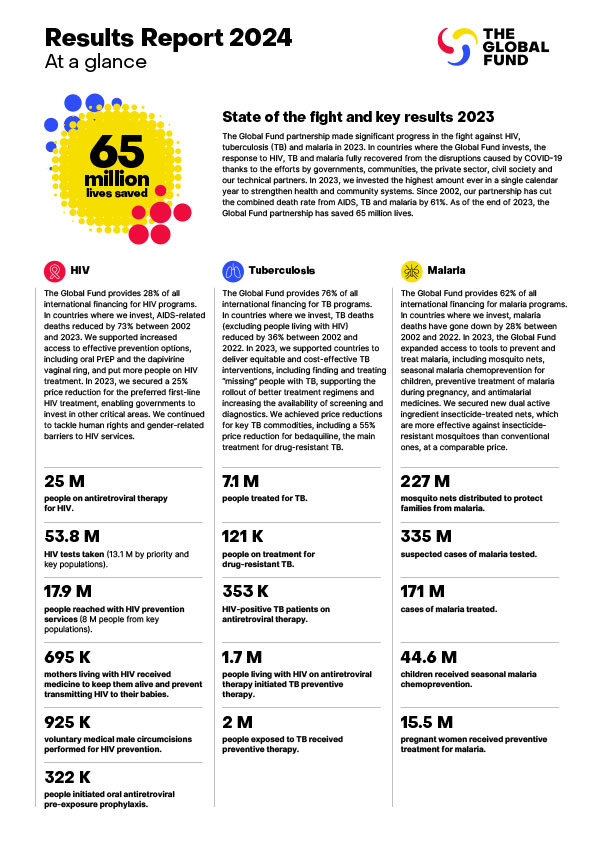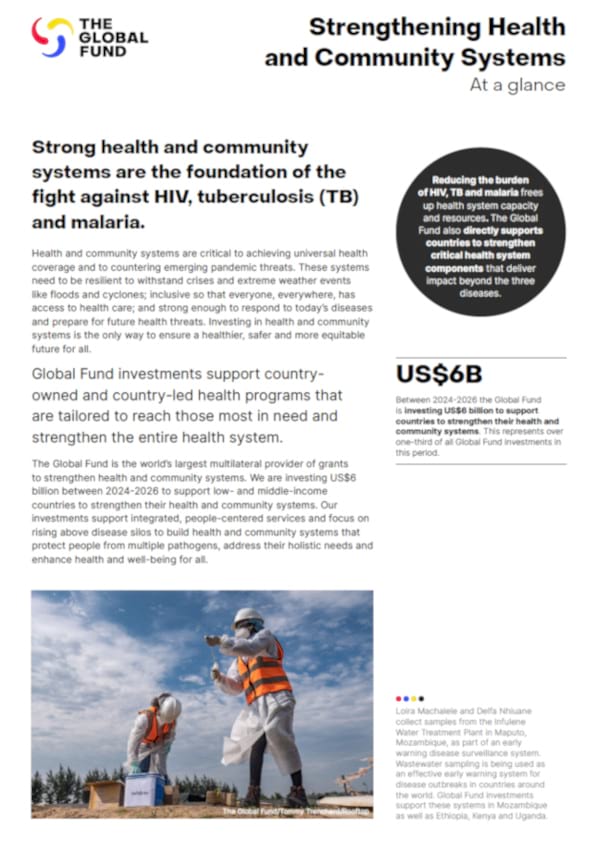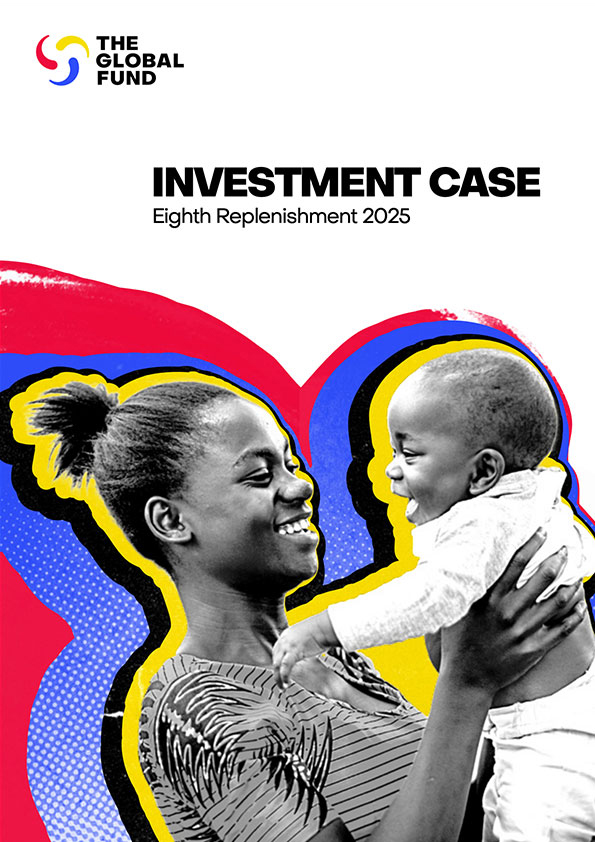Elimination of HIV transmission from mother to child by 2015 within reach
08 March 2010
Dramatic reduction in malaria deaths by 2015 possible; on track to meet global TB targets
Geneva – Virtual elimination of mother to child HIV transmission by 2015 is now within reach if current rates of progress by Global Fund-supported programs and other efforts are maintained. Malaria may be eliminated as a public health problem within a decade in most countries where it is endemic. Tuberculosis prevalence in many countries is declining and the international target of halving TB prevalence could be met by 2015.
These are projections from the Global Fund’s 2010 Results Report, released today. They are contingent on the current rate of scaling up of health investments for the three diseases being at least maintained and ideally accelerated further.
“A world where no children are born with HIV is truly possible by 2015,” says Professor Michel Kazatchkine, Executive Director of the Global Fund. “It is also possible now to imagine a world with no more malaria deaths, since already an increasing number of countries have been reporting a reduction in malaria deaths of more than 50 percent over the past couple of years. No other area of development has seen such a direct and rapid correlation between donor investments and live-saving impact as these investments in fighting AIDS, TB and malaria.”
According to the report, Global Fund-supported programs saved at least 3,600 lives per day in 2009 and an estimated total of 4.9 million since the creation of the Global Fund in 2002. These are people who would otherwise be dead, had it not been for interventions supported by the Global Fund.
“The Global Fund is about getting results. This report clearly shows the world’s investments are making a difference,” said Mr Michel Sidibé, Executive Director of UNAIDS. “However AIDS is not over in any part of the world and without a fully funded Global Fund, our shared dream of universal access to HIV prevention, treatment care and support could become our worst nightmare—putting the lives of millions of people currently on treatment in jeopardy and millions of pregnant women in a position not able to protect their babies from becoming infected.”
The Results Report forms part of the documentation for donors in preparation for the Global Fund’s replenishment conference in October 2010 in New York, where the organization will ask donors for financial contributions for 2011-2013. This is the third time since the Global Fund was established in 2002 that donors are being asked to replenish its finances.
At an initial Replenishment review meeting to be held in The Hague on 24 March, the Global Fund is presenting three resource scenarios for consideration to donors, each with an indication of the results that could be expected in terms of achievements on the ground at the end of the replenishment period. The different scenarios range from US$ 13 to 20 billion for the three-year period.
By the end of 2009, Global Fund-supported programs provided antiretroviral treatment to 2.5 million people, treatment to 6 million people who had active TB and had distributed 104 million insecticide-treated nets to prevent malaria. In addition to averting at least 3,600 deaths daily, the programs prevent thousands of new infections and alleviate untold suffering and economic loss for poor families in 144 countries.
Established as a public-private partnership to mobilize and intensify the international response to the three global epidemics and help achieve the UN Millennium Development Goals (MDGs), the Global Fund has disbursed US $10 billion for HIV, TB and malaria efforts through December 2009.
The coming years will see even more results, as half of the total disbursements by the Global Fund were delivered in 2008 and 2009. In addition, much of the US$ 5.4 billion of financing approved in the last two rounds of proposals (8 and 9) will reach countries in 2010 and 2011, and will continue to significantly boost health outcomes.
The progress in combating AIDS, TB and malaria as a result of these investments has also had a positive impact on child mortality and maternal health. The MDGs call for halting and reversing the major diseases as well as reducing child mortality and improving maternal health by 2015.
Global Fund grants have made significant contributions to reducing the largest causes of mortality among women and children. This is particularly the case in sub-Saharan Africa, where HIV, TB and malaria are responsible for 52 percent of deaths among women of childbearing age and malaria alone accounts for 16 to 18 percent of child deaths.
Results by disease, up to December 2009
HIV
- 2.5 million people are currently on antiretroviral therapy (ART), a level of coverage deemed unattainable less than a decade ago.
- AIDS mortality has declined in many high-burden countries.
- The Global Fund contributed about one-fifth of all disbursements by bi- and multilaterals for the HIV response in low- and middle-income countries in 2008.
- 1.8 billion condoms distributed.
- 105 million HIV counseling and testing sessions provided.
- 790,000 HIV-positive pregnant women in low- and middle-income countries received antiretroviral prophylaxis to prevent mother-to-child transmission– which represents 45 percent of coverage of women in need.
- 4.5 million basic care and support services provided to orphans and other children made vulnerable by AIDS.
Tuberculosis
- Around 6 million people with active TB were treated by December 2009.
- 1.8 million TB/HIV services provided – a 150 percent increase since the end of 2008, contributing to the decline of TB prevalence and mortality rates in many countries.
- The Global Fund provides 63 percent of the external financing for TB and multidrug-resistant TB (MDR-TB) control efforts in low- and middle-income countries – it is by far the major source of international funding for tuberculosis.
- Today, countries are on track to meet the international target of halving TB prevalence by 2015.
Malaria
- 104 million insecticide-treated nets distributed to prevent malaria; more than 19 million indoor residual spraying of insecticides in dwellings; 108 million cases of malaria treated in accordance with national treatment guidelines.
- An increasing number of countries reporting a reduction in malaria deaths of more than 50 percent. At least ten of the most endemic countries in Africa have reported declines in new malaria cases and an impressive decline in child mortality of 50 to 80 percent.
- In 2008, the Global Fund contributed 57 percent of international disbursements for malaria control – which makes it, by far, the major source of international funding for malaria.
- In Africa, Swaziland and some island states and territories are now aspiring to enter the malaria pre-elimination stage.
Progress towards meeting Millennium Development Goals
The report points out that continued, substantial increases in long-term financial commitments by donors will be needed to consolidate the gains and to reach the MDGs by 2015.
Within that time-frame, 2010 is decisive.
Funds committed now will benefit programs which will have effect on the ground from 2012 to 2015. The numbers show that countries are approaching a positive tipping point: if they continue on this path, the returns will be exponential and the world will reverse the AIDS, TB and malaria epidemics.
“In health, 2010 is a pivotal year to finance the final stretch of the effort to reach the Millennium Development Goals”, says Professor Kazatchkine. “We have made unprecedented progress but it is fragile. If we lose momentum now there will be a heavy price to pay. A failure to continue the scale-up of investments in health will betray the trust of millions.”
Examples of country’s successes in the fight against the three diseases can be found throughout the report. Three such examples are South Africa in HIV and AIDS, China in tuberculosis and Rwanda in malaria.
South Africa has stepped up a rapid expansion of HIV prevention, care and treatment services. The Global Fund disbursed US$ 97.2 million for HIV grants and US$ 87.2 million for TB/HIV grants by the end of 2009 to support the South African efforts to respond to HIV. Activities focused mainly on behavior change communication, provision of ART and TB/HIV collaborative activities. Initially, the Global Fund financed much of the scale-up of ART, but more recently the government has assumed financial responsibility for provision of ART. Between December 2007 and December 2008, the number of people receiving ART in South Africa increased by 53 percent, from 458,951 to 700,500. As ART coverage has increased, mortality rates, which had been rapidly increasing in previous years, stabilized.
The Global Fund has made a substantial contribution to China’s TB control efforts, with a total approved amount of US$ 452.3 million, of which US$ 165.6 million was disbursed by the end of 2009, accounting for about 15 percent of the national TB program budget. In 2007, China had achieved 100 percent DOTS – the basic package that underpins the Stop TB strategy - coverage and an 80 percent case detection rate for new smear-positive cases. Treatment success reached 93 percent, exceeding the international target of at least 85 percent. The TB burden in China has been steadily declining. Between 2000 and 2008 the TB mortality rate declined from 9.8 to 5.4 per 100,000 population. However, Multi-drug resistant TB is increasing in some parts of China and is becoming a major challenge.
Rwanda. In 2006, the Rwandan Ministry of Health launched a massive scale-up of long lasting insecticidal nets (LLINs) and artemisinin combination therapies. Of an approved amount of US$ 131.1 million for malaria grants, the Global Fund had disbursed US$ 107.5 million as of the end of 2009. The massive scale-up of malaria interventions has led to a rapid decline in malaria cases and has freed up capacity in the health system to manage other health problems. Data from selected health facilities show that inpatient malaria cases in 2007 declined by 56 percent compared to the annual average for the years 2001–2006. At the same time, there was a 59 percent increase in non-malaria inpatient cases in 2007, as hospital beds became available for the treatment of other diseases.
